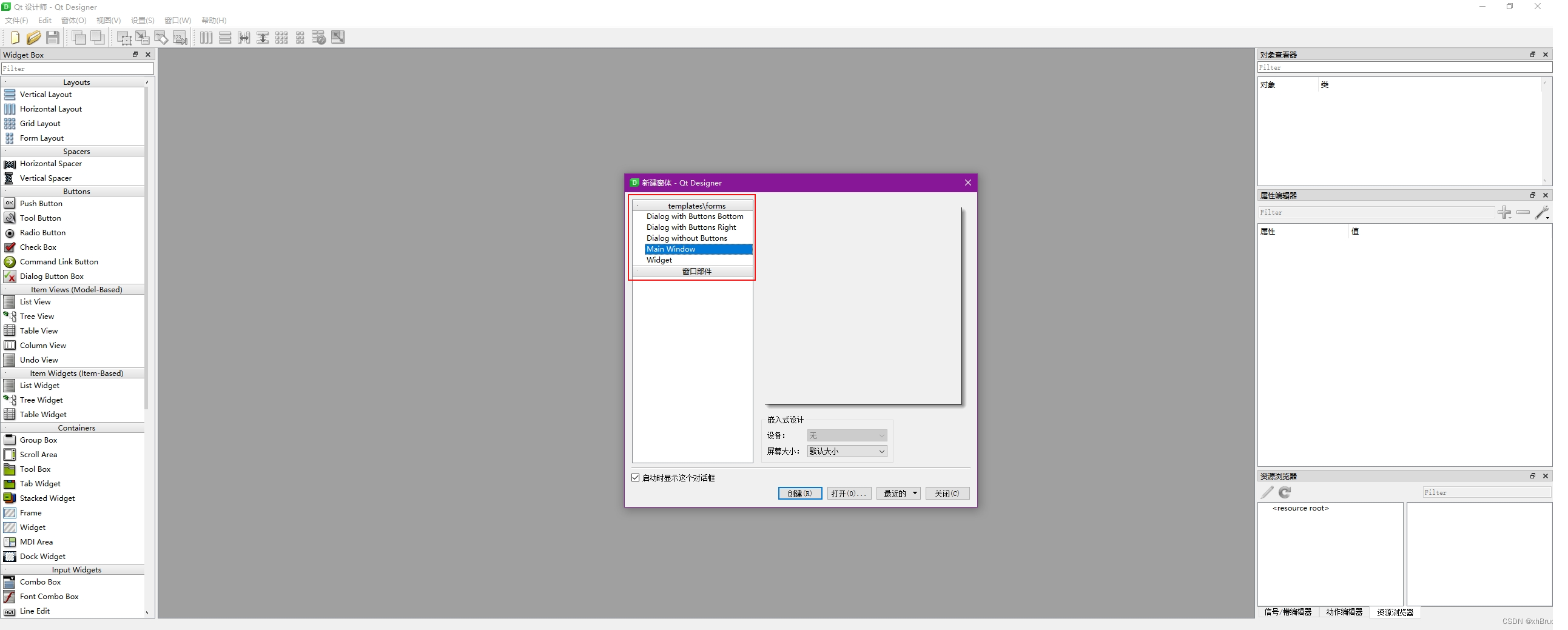PyQt5开始入门
1、使用 Qt designer
查看 pyQt5 + pycharm 配置安装
PyQt5、PyQt5-tools;使用Qt designer生成ui文件并用PyUic工具转换成py文件
1.1 配置Qt designer外部工具:两种方式
pyqt5-tools.exe:pyqt5-tools.exe designer
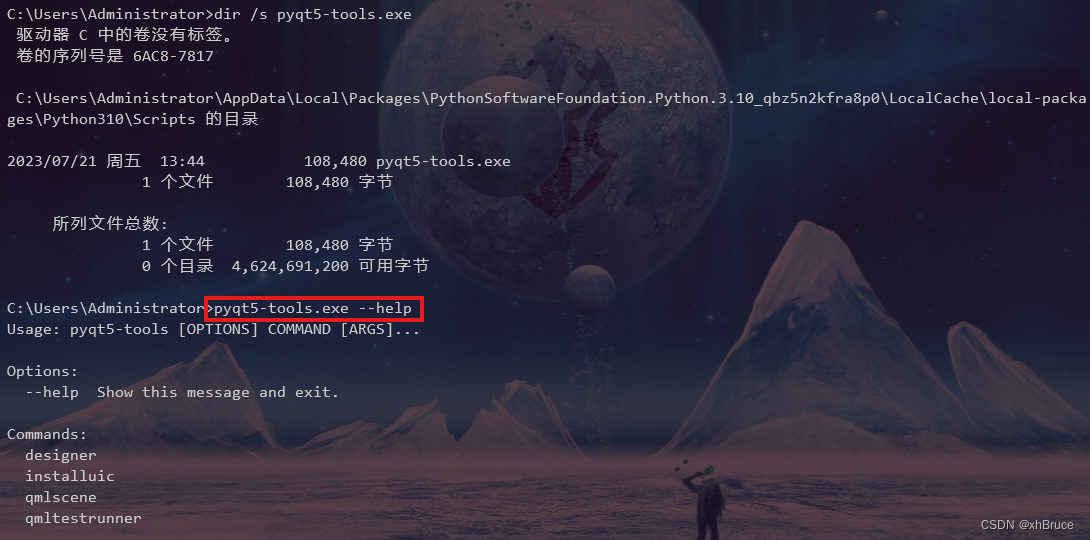
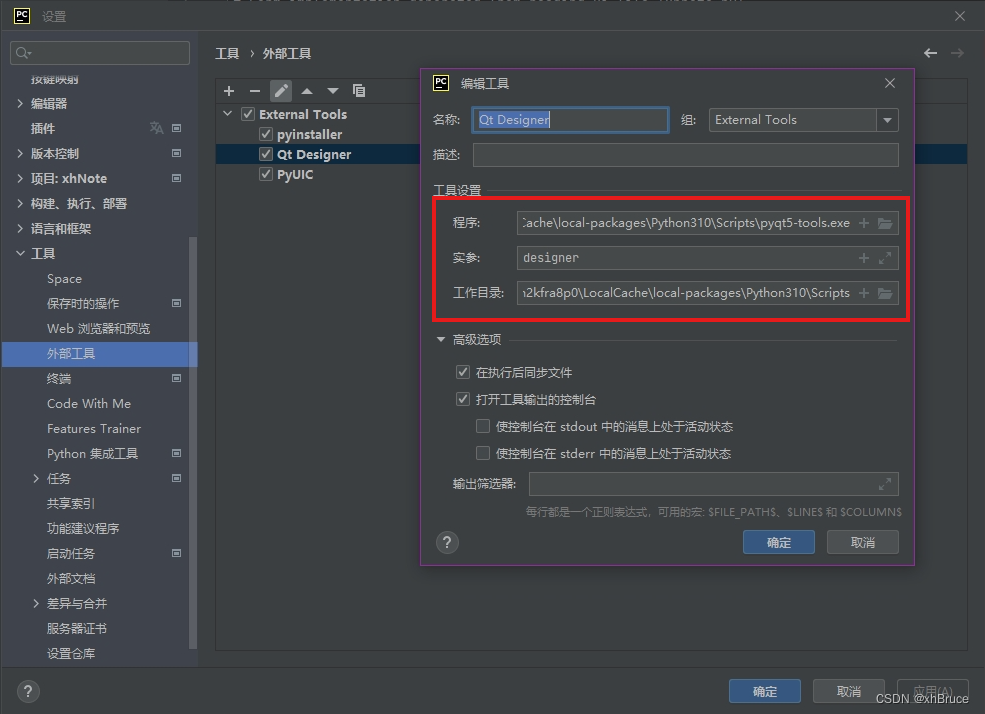
2. designer.exe

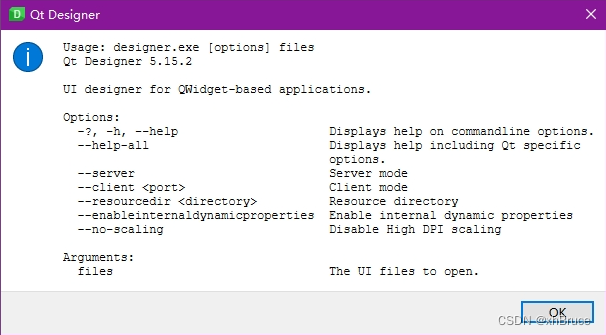
1.2 配置PyUIC外部工具

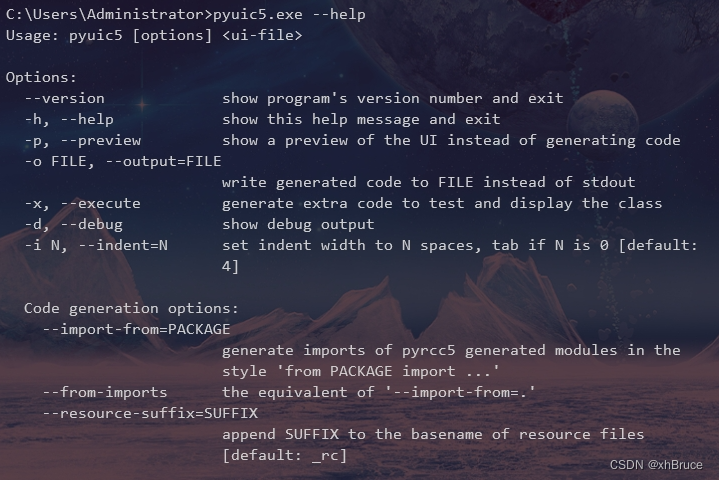
1.3 添加入口main运行结果
import sys
if __name__ == '__main__':
app = QtWidgets.QApplication(sys.argv)
MainWindow = QtWidgets.QMainWindow()
ui = Ui_MainWindow()
ui.setupUi(MainWindow)
MainWindow.show()
sys.exit(app.exec_())
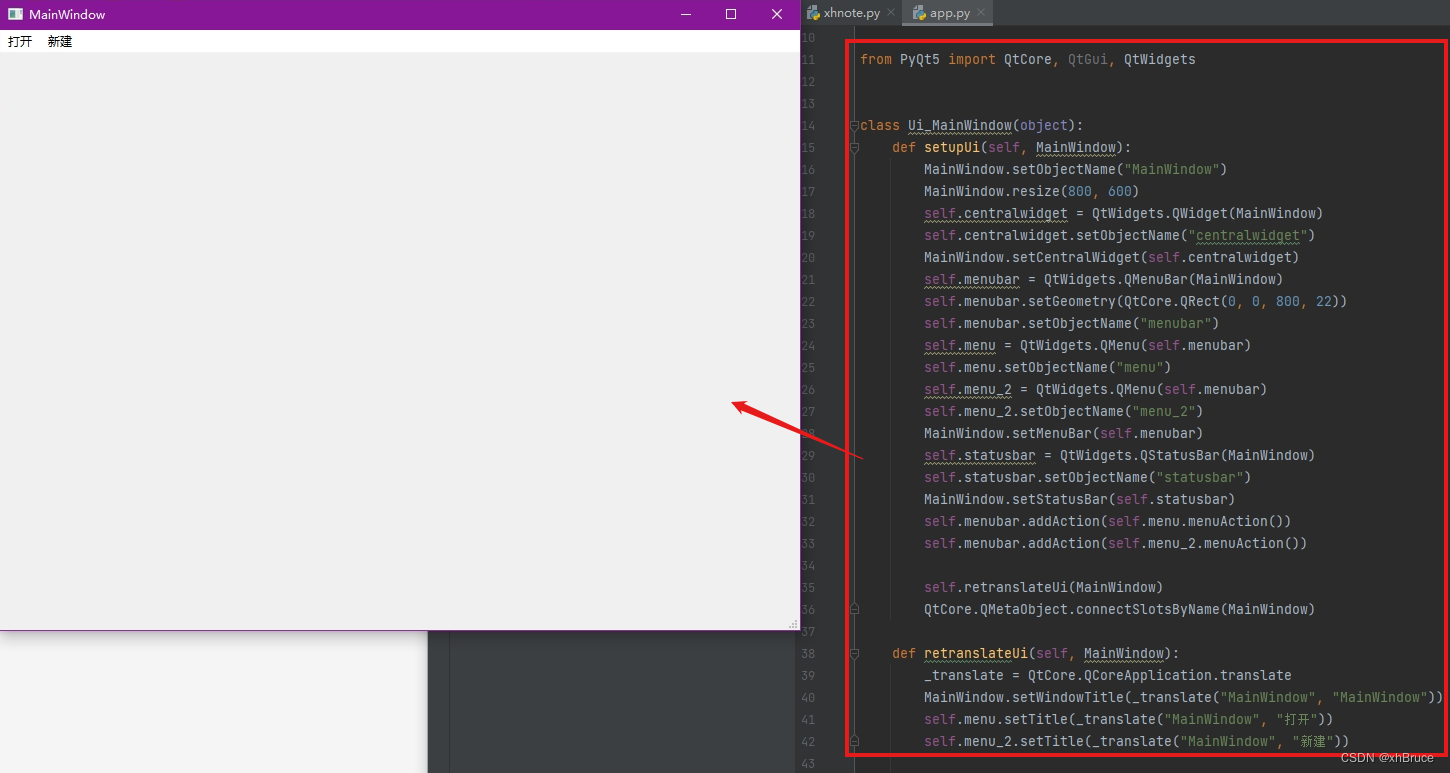
2、简单的窗口
QtWidgets.QApplication(sys.argv) 提供了整个图形界面程序的底层管理功能,比如:
初始化、程序入口参数的处理,用户事件(对界面的点击、输入、拖拽)分发给各个对应的控件,等等…
- 每个PyQt5应用都必须创建一个应用对象。sys.argv是一组命令行参数的列表。Python可以在shell里运行,这个参数提供对脚本控制的功能。
app.exec_()进入了应用的主循环中,事件处理器这个时候开始工作。主循环从窗口上接收事件,并把事件派发到应用控件里。当调用exit()方法或直接销毁主控件时,主循环就会结束。sys.exit()方法能确保主循环安全退出。外部环境会收到主控件如何结束的信息。
QtWidgets.QMainWindow() 界面的主窗口,继承
QMainWindow(QWidget),MainWindow.show()能让控件在桌面上显示出来;QtWidgets.QWidget(MainWindow)QWidge控件是一个用户界面的基本控件,它提供了基本的应用构造器。默认情况下,构造器是没有父级的,没有父级的构造器被称为窗口(window)。
# -*- coding: utf-8 -*-
# Form implementation generated from reading ui file 'app.ui'
#
# Created by: PyQt5 UI code generator 5.15.9
#
# WARNING: Any manual changes made to this file will be lost when pyuic5 is
# run again. Do not edit this file unless you know what you are doing.
from PyQt5 import QtCore, QtGui, QtWidgets
class Ui_MainWindow(object):
def setupUi(self, MainWindow):
MainWindow.setObjectName("MainWindow")
MainWindow.resize(800, 600)
self.centralwidget = QtWidgets.QWidget(MainWindow)
self.centralwidget.setObjectName("centralwidget")
MainWindow.setCentralWidget(self.centralwidget)
self.menubar = QtWidgets.QMenuBar(MainWindow)
self.menubar.setGeometry(QtCore.QRect(0, 0, 800, 22))
self.menubar.setObjectName("menubar")
self.menu = QtWidgets.QMenu(self.menubar)
self.menu.setObjectName("menu")
self.menu_2 = QtWidgets.QMenu(self.menubar)
self.menu_2.setObjectName("menu_2")
MainWindow.setMenuBar(self.menubar)
self.statusbar = QtWidgets.QStatusBar(MainWindow)
self.statusbar.setObjectName("statusbar")
MainWindow.setStatusBar(self.statusbar)
self.menubar.addAction(self.menu.menuAction())
self.menubar.addAction(self.menu_2.menuAction())
self.retranslateUi(MainWindow)
QtCore.QMetaObject.connectSlotsByName(MainWindow)
def retranslateUi(self, MainWindow):
_translate = QtCore.QCoreApplication.translate
MainWindow.setWindowTitle(_translate("MainWindow", "MainWindow"))
self.menu.setTitle(_translate("MainWindow", "打开"))
self.menu_2.setTitle(_translate("MainWindow", "新建"))
2.1 带窗口图标
窗口图标通常是显示在窗口的左上角,标题栏的最左边。准备图片
icon.ico,创建一个QIcon对象,设置左上角图标MainWindow.setWindowIcon(),setWindowTitle设置左上角标题;上面的两个方法都继承自QWidget类
from PyQt5 import QtCore, QtGui, QtWidgets
from PyQt5.QtGui import QIcon
class Ui_MainWindow(object):
def setupUi(self, MainWindow):
# ... ...
MainWindow.setWindowTitle("XhNote")
icon = QIcon("icons/icon.ico")
MainWindow.setWindowIcon(icon)
# ... ...

2.2 提示框
QToolTip.setFont(QFont('SansSerif', 10))这个静态方法设置了提示框的字体,我们使用了10px的SansSerif字体。
mainQwidget.setToolTip('This is a <b>QWidget</b> widget')中央widget鼠标悬停提示
btn.setToolTip('This is a <b>QPushButton</b> widget')按钮鼠标悬停提示
from PyQt5 import QtCore, QtWidgets
from PyQt5.QtGui import QIcon, QFont
from PyQt5.QtWidgets import QPushButton, QToolTip
class Ui_MainWindow(object):
def setupUi(self, MainWindow):
# ... ...
mainQwidget = QtWidgets.QWidget(MainWindow)
QToolTip.setFont(QFont('SansSerif', 10))
mainQwidget.setToolTip('This is a <b>QWidget</b> widget')
btn = QPushButton('Button', mainQwidget)
btn.setToolTip('This is a <b>QPushButton</b> widget')
btn.resize(btn.sizeHint())
btn.move(50, 50)
mainQwidget.setWindowTitle('Tooltips')
#
self.centralwidget = mainQwidget
self.centralwidget.setObjectName("centralwidget")
MainWindow.setCentralWidget(self.centralwidget)
# ... ...
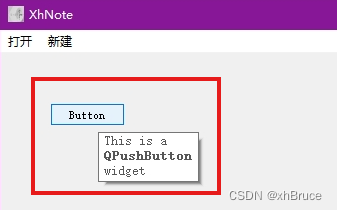

2.3 关闭窗口
qbtn.clicked.connect(QCoreApplication.instance().quit)事件传递系统在PyQt5内建的single和slot机制里面。点击按钮之后,信号会被捕捉并给出既定的反应。QCoreApplication包含了事件的主循环,它能添加和删除所有的事件,instance()创建了一个它的实例。QCoreApplication是在QApplication里创建的。 点击事件和能终止进程并退出应用的quit函数绑定在了一起。在发送者和接受者之间建立了通讯,发送者就是按钮,接受者就是应用对象。
from PyQt5 import QtCore, QtWidgets
from PyQt5.QtCore import QCoreApplication
from PyQt5.QtGui import QIcon
from PyQt5.QtWidgets import QPushButton
class Ui_MainWindow(object):
def setupUi(self, MainWindow):
# ... ...
mainQwidget = QtWidgets.QWidget(MainWindow)
qbtn = QPushButton('退出', mainQwidget)
qbtn.clicked.connect(QCoreApplication.instance().quit)
#
self.centralwidget = mainQwidget
self.centralwidget.setObjectName("centralwidget")
MainWindow.setCentralWidget(self.centralwidget)
# ... ...
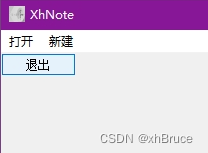
2.4 消息盒子
默认情况下,我们点击标题栏的×按钮,QWidget就会关闭。但是有时候,我们修改默认行为。比如,如果我们打开的是一个文本编辑器,并且做了一些修改,我们就会想在关闭按钮的时候让用户进一步确认操作。
如果关闭QWidget,就会产生一个QCloseEvent,并且把它传入到closeEvent函数的event参数中。改变控件的默认行为,就是替换掉默认的事件处理。
我们创建了一个消息框QMessageBox.question(),上面有俩按钮:Yes和No.第一个字符串显示在消息框的标题栏,第二个字符串显示在对话框,第三个参数是消息框的俩按钮,最后一个参数是默认按钮,这个按钮是默认选中的。返回值在变量reply里。
import sys
from PyQt5.QtWidgets import QWidget, QMessageBox, QApplication, QDesktopWidget
class Example(QWidget):
def __init__(self):
super().__init__()
self.initUI()
def initUI(self):
self.setGeometry(300, 300, 250, 150)
self.setWindowTitle('Message box')
self.center()
self.show()
def center(self):
qr = self.frameGeometry()
cp = QDesktopWidget().availableGeometry().center()
qr.moveCenter(cp)
self.move(qr.topLeft())
def closeEvent(self, event):
reply = QMessageBox.question(self, 'Message',
"Are you sure to quit?", QMessageBox.Yes |
QMessageBox.No, QMessageBox.No)
if reply == QMessageBox.Yes:
event.accept()
else:
event.ignore()
if __name__ == '__main__':
app = QApplication(sys.argv)
ex = Example()
sys.exit(app.exec_())
2.5 窗口居中
QtGui.QDesktopWidget提供了用户的桌面信息,包括屏幕的大小。qr = self.frameGeometry()获得主窗口所在的框架。cp = QDesktopWidget().availableGeometry().center()获取显示器的分辨率,然后得到屏幕中间点的位置。qr.moveCenter(cp)然后把主窗口框架的中心点放置到屏幕的中心位置。self.move(qr.topLeft())然后通过move函数把主窗口的左上角移动到其框架的左上角,这样就把窗口居中了。
(qr.moveCenter(cp)注释后窗口就在屏幕左上角显示)
from PyQt5 import QtCore, QtWidgets
from PyQt5.QtCore import QCoreApplication
from PyQt5.QtGui import QIcon
from PyQt5.QtWidgets import QPushButton, QDesktopWidget
class Ui_MainWindow(object):
def setupUi(self, MainWindow):
# ... ...
self.center(MainWindow)
def center(self, MainWindow):
qr = MainWindow.frameGeometry()
cp = QDesktopWidget().availableGeometry().center()
qr.moveCenter(cp)
MainWindow.move(qr.topLeft())
